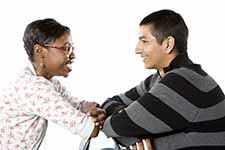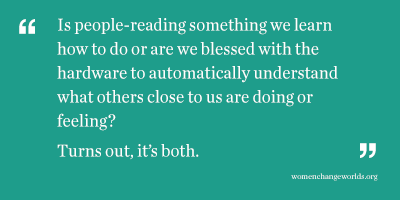
The Four R’s – Reading, ’Riting, ’Rithmetic, and Resonance
Do you have someone in your life that “gets” you? I do. My friend Angel and I see each other every six weeks or so but each time we get together I am struck by the resonance we share, the ability to jump back into a conversation as if no time has passed. How does that happen? When I heard about the discovery of mirror neurons I thought I had found the answer.
First discovered by accident in 1998 by scientists studying arm movements in monkeys, mirror neurons were originally described as individual, specialized brain cells with the sole purpose to help us “get” or read other people. They were thought to be unique among brain cells because of their ability to multitask—registering actions, feelings and sensations all in a single specialized cell. I loved this! My heart already believed that relationships were central to health and wellness and these mirror neurons could be the proof my brain needed to believe that humans are “hardwired to connect.” But, even as I was sharing the news with others, I felt a little worried. How could Angel and I click so easily when I struggled with many other relationships in my life?
Also, when I looked at my friends and family, I noticed I was not alone. Everyone I know has some variability in his or her capacity to read others and to be read. So, if we’re hardwired to connect, what explains the variability? Is people-reading something we learn how to do or are we blessed with the hardware to automatically understand what others close to us are doing or feeling? Turns out, it’s both.
As babies, we are born with reflexes to connect with others. Watch an infant for a few minutes and you can see the vast amount of energy devoted to connection. The wiggling and writhing invested in finding the nipple of a full breast, the waving of a tiny, unsteady hand in search of a finger to wrap around or the neck to grab hold of. These reflexes are a pretty good start for connection, but, are not nuanced enough to allow an infant to “read the room.” A baby may become fussy when held by a distracted, tense mother but could not “know” the mother arrived home from work exhausted and irritable after being up all night working on an important presentation.
Researchers are now describing a mirror neuron system rather than unique mirror neurons. This is a more complex, efficient, and coordinated wiring of existing of neural pathways that communicate the actions feelings, and sensations of those around us. It is the way these pathways become interconnected through experience that really counts in clicking with others and making sense of relationships. Imitation plays a key role. Each of us literally “knows” other people by mimicking them internally. This mimicking is concrete. If I watch you walk toward the door with your hand out, I “spontaneously and automatically “know you are going to open the door and leave. I do not need to ask.  Deep in my brain, the area in the prefrontal cortex that plans and executes the physical movement of walking out the door is being stimulated. Though I am not moving, the same nerve cells are firing. When you touch the door and pull your hand away quickly and shake it a little I “know” that the door was quite hot from the pounding sunshine on the glass. My somatosensory cortex that creates sensations fires and my hand feels a low-grade sense of heat and smoothness from the window window. That is added to the immediate mix of how I am reading your experience. And finally, you walk through the door and a large smile crosses your face as you fall into the arms of a loved one. In my brain and body the nerve signal has now traveled through the insula into my “feeling centers” in my body and I feel a similar joy and lightness. I “know” you are with someone you love. All of this has happened in the blink of an eye and without you sharing any of your experience with me. My brain and body uses itself as a template to have a shared experience with you and the closer our life experiences internally have been, the more resonant we feel.
Deep in my brain, the area in the prefrontal cortex that plans and executes the physical movement of walking out the door is being stimulated. Though I am not moving, the same nerve cells are firing. When you touch the door and pull your hand away quickly and shake it a little I “know” that the door was quite hot from the pounding sunshine on the glass. My somatosensory cortex that creates sensations fires and my hand feels a low-grade sense of heat and smoothness from the window window. That is added to the immediate mix of how I am reading your experience. And finally, you walk through the door and a large smile crosses your face as you fall into the arms of a loved one. In my brain and body the nerve signal has now traveled through the insula into my “feeling centers” in my body and I feel a similar joy and lightness. I “know” you are with someone you love. All of this has happened in the blink of an eye and without you sharing any of your experience with me. My brain and body uses itself as a template to have a shared experience with you and the closer our life experiences internally have been, the more resonant we feel.
But imitating is not the whole story. Grown-ups must name feelings and experiences accurately when you are little so that when you name them in others later they match. You fall down and skin your knee and your parent says, “Ouch, that hurts.” The pain in your knee and the tears running down your face are paired with being hurt. A friend knocks over your block tower and the energy surging through your body and the tension in your eyebrows and face gets paired with a teacher saying, “You feel angry because Tom knocked over your blocks.” It seems like an easy process except that many people don’t know what feelings feel like in their body. Even as adults, well-meaning parents can mislabel a child’s experience and potentially confuse the development of the mirror neuron system.
Here’s an example. Ten years ago my pre-school aged twins and I were in a terrifying accident. I had driven the one-mile route to school mindlessly for a couple of years. On this day, as we approached a four-way intersection, another van turned left and hit us almost head on. Both vans were totaled and immediately chaos ensued. The front airbags in our car deployed filling up most of the front seat and giving off a pungent, rubber smell; the engine hissed and sent water and steam spraying into the air. Within minutes the local rescue teams arrived en masse—fire, police, and ambulance sped to the accident with blaring sirens and lights. In the midst of the overstimulation, I crawled into the back seat and looked directly into the trusting, scared faces of my children and said, “Everything is fine”—a delusional thought if ever I had one. My son looked right back at me and said, “Everything is not fine, this is a bad accident. “ A reality check for sure, I immediately backtracked and agreed that it was a bad accident and that it was scary.
We develop these pathways for accurate reading in the context of being accurately read by others! When I tell my children everything is fine at the same time their bodies are registering that things are dangerous, their developing people-reading pathways are getting a mixed message. Done often enough, as is often the case with childhood trauma or domestic violence, and the person’s mirror neuron system wires in an inaccurate and confusing way. They drift into isolation as their capacity for resonance is diminished.
A cultural belief that human development should be towards increased levels of separation and individuation can create a mirror neuron system that is not accurate. If I am busy “hiding my feelings” from you for fear of being seen as weak or needy, or if I believe that being impacted by another person’s feelings or experiences diminishes my strength, then chances are my mirror neuron system is not getting the stimulation needed to develop the essential human capacity of resonating and reading others and being read. And the impact of this is far reaching. Human beings are built to be healthiest in mind and body when in strong connections with others. Connection and cooperation are part of the everyday lives of most people and a strong mirror neuron system is essential in each and every one of life’s negotiations. It is high time that we add the fourth “R” to the basic skills taught in education—reading, ‘riting, ’rithmetic, and resonance!
Amy Banks, M.D., has devoted her career to understanding the neurobiology of relationships. She was an instructor of psychiatry at Harvard Medical School and is the Director of Advanced Training at the Jean Baker Miller Training Institute (JBMTI) at the Wellesley Centers for Women at Wellesley College. She is the author with Leigh Ann Hirschman of the forthcoming book, Four Ways to Click: Rewire your Brain for Stronger, More Rewarding Relationships (Penguin Random House).
When you subscribe to the blog, we will send you an e-mail when there are new updates on the site so you wouldn't miss them.
Comments